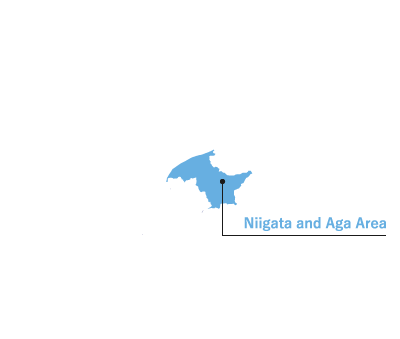
So many exciting activities to try! A fun-filled summer itinerary through Niigata City and Sado




1
Pier Bandai (Peekan Terrace)
-
Pier Bandai is both a tourist attraction and local market, packed with things to do and eat. It boasts a wide assortment of Niigata specialty products and hosts numerous restaurants. Its Peekan Terrace serves as a backdrop for periodic events, and from April to October, you can enjoy an outdoor BBQ.
For the BBQ, you can purchase your preferred ingredients like fresh Niigata seafood, meat, and vegetables from the market conveniently located next door. Alternatively, there are set courses available serving up carefully selected ingredients. It’s just a short 15-minute walk from Niigata Station, and free Wi-Fi is available, making it great for travelers.
Peekan Terrace is a fantastic spot to make the most of a beautiful day in Niigata!
Opening Season: Mid-April to early October
*Depends on the year. Please refer to the official website for details.
Opening Hours: 11:00 am - 9:00 pm
Location: Pier Bandai (Peekan Terrace)

2
Japanese Wind Chime Workshop
-
The melodious tones of wind chimes epitomize Japanese summer tradition. People often adorn the eaves of their homes with these artistic creations, finding solace in the soothing sounds as they sway with the breeze. In this experience, you will assemble components made in Niigata to create a lovely glass wind chime. It's an excellent opportunity to fashion an original piece that encapsulates the essence of Japan, making it an ideal keepsake or gift.
For those eager to delve deeper into the intricacies of wind chime craftsmanship, this informative tour includes a visit to a glass factory where they come to life. Participants can make wind chimes with designs tailored to the season and even opt for a hot spring excursion in Niigata City.

3
Mizbering
-
Mizberingu is a joint project between the government and private sector to bring new vibrancy to waterfronts throughout Japan.
Niigata’s Mizberingu is set up over a 500-meter stretch on the Yasuragitei Embankment by the Shinano River, near the iconic Bandai Bridge. Between mid-June and late September, the Mizbe Outdoor Lounge opens on the right riverbank, designed by popular outdoor brand Snow Peak. You’ll be able to enjoy meals at stalls from a bunch of well-known Niigata City restaurants and more while basking in the magnificent waterfront scenery.
Day camping is also available between April and October.
Relish a refreshing outdoor experience in the middle of Niigata City, just a 15-minute walk from Niigata Station.

4
[Accommodation] Hotel Nikko Niigata
-
"Nestled along the banks of the Shinano River, which flows through the heart of Niigata City, Hotel Nikko Niigata stands as the city's landmark with architecture inspired by a luxury cruise ship adrift on the water. The guest rooms offer the best views of the city, and patrons can enjoy the stunning landscapes of the Shinano River and Bandai Island as they dine in the hotel restaurant. Scattered throughout the hotel are various scenic viewpoints, with the highlight being the banquet hall on the 30th floor with glass windows that offer a breathtaking 180-degree panoramic view of the surroundings. Their renowned buffet-style breakfast is prepared with products and ingredients from Niigata, including Uonuma Shiozawa Koshihikari rice.
The hotel is conveniently located approximately 8 minutes by car from Niigata Station and offers direct access to the Sado Kisen ferry terminal. The prime location makes Hotel Nikko Niigata an ideal hub for your explorations around Niigata, providing a smooth and delightful travel experience."

1 hour 10 minutes by jetfoil from Sado Kisen Niigata Port Terminal to Ryotsu Port Terminal
4-minute walk from Sado Kisen Ryotsu Port Terminal
5
Sado Outdoor Base
-
Situated within a mere 4-minute walk from Ryotsu Port Sado Kisen Terminal, the entry point to Sado Island, Sado Outdoor Base stands as a conveniently located tourist hub for those eager to immerse themselves in the natural wonders of Sado Island.
Along with handling tours and providing information, the facility offers rental services for bicycles, trekking equipment, fishing gear, and more. Additionally, there is a boutique store with trendy outdoor merchandise, as well as changing rooms and shower facilities, allowing you to relish the outdoors unencumbered.
After your adventure, indulge in a satisfying meal with a hefty hamburger from the on-site café. The café also serves popular beverages such as Sado apple juice and Sado "bancha" green tea.

50 minutes by public bus or 35 minutes by taxi from Ryotsu Port Terminal
6
[Accommodation] Urashima
-
The East Building was designed by Hiroshi Naito, one of Japan’s representative architects, and stands in brilliant harmony with the natural world of Sado. The modern, glass-sided South Building was also created by a famous Japanese architect: Koh Kitayama.
This hotel with two faces is known for its delicious meals, which allow you to savor fresh Sado ingredients in high-class Japanese or French cuisine. Its location facing a shallow and calm beach is another of its charms.

7
Taraibune Tub-Boat Ride (Yajima Taiken Koryukan)
-
“Taraibune” tub-boats were originally built for "isonegi-ryo," a fishing method where a glass box is used to look underwater for seafood from a floating tub. It was used to collect seaweed, abalone, turban shells, and more from the narrow, rocky, and reef-filled Ogi Coast. It is said to have been based on a laundry tub, and improved over time to its current form.
Yajima Taiken Koryukan, a facility on the cove with a view of Yajima and Kyojima islands, offers taraibune tub-boat rides for visitors. Explore the cove on a tub-boat and relish the picturesque scenery of Sado Island!

8
Shukunegi
-
Lying at the very southern tip of Sado City, Shukunegi was once a prosperous hub for cargo vessels. The livelihoods of the entire population of the village were related to cargo vessels in some way, from ship owners, to sailors, carpenters, blacksmiths and coopers.
The rows of houses in Shukunegi, made with a combination of shipbuilders' skills and techniques, are designated as a National Important Preservation Area for Traditional Buildings and Architecture. The maze-like narrow lanes remain as they were in olden days and even today there are more than 100 wooden-paneled two-storied structures. The outer walls of the houses are made of vertically grained timber called tsutsumi-ita (wrapping planks) that protect the houses against sea breezes blowing off the Sea of Japan. In contrast with the simple appearance of the outside, the interiors have elaborate designs with much lacquer coating.
Three of the houses believed to have been built between the early and mid-19th century are open to the public (fee payable) and convey to visitors the history of this small hamlet, where all people were engaged in work relating to shipbuilding and shipping. Why not come for a stroll around this quiet community where people’s lives and history intersect?

9
Nishimikawa Gold Park
-
The area surrounding the Nishimikawa River has long been known as a prime location for discovering gold dust. Nishimikawa Gold Park is a museum where you can get hands-on gold panning experience that’s located next to Nishimikawa Gold Mine, the oldest gold mine in Sado.
The facility features numerous exhibits where visitors can learn about the properties of gold, the formation of gold dust, techniques for gold panning, and other fascinating facts related to gold. It is the only place in Sado that lets visitors try their hand at gold panning. The staff are readily available to assist with the process, so anyone can have a go at it. Any gold discovered can be processed into charms and pendants on the spot for an additional fee.
The on-site gift shop offers a wide range of products, from precious metals to unique snacks and processed foods made from local ingredients, making it an ideal place to purchase souvenirs and mementos.










































